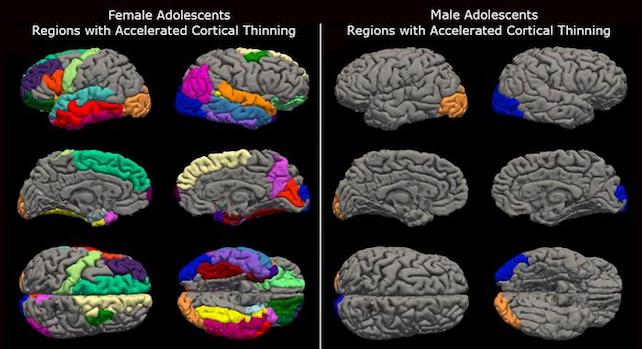Lockdowns saved lives during the COVID-19 pandemic. Research suggests they saved roughly 1 million lives in the first half of 2020 in the US alone.
Confining people to their homes and neighborhoods changed lives, however, and often for the worse. On top of wreaking economic havoc, COVID lockdowns kept people of all ages away from schools, offices, and other social hubs, plunging many into loneliness.
Children were among those hit hardest, and while the effects remain murky, studies indicate teenagers were uniquely vulnerable to the social upheaval.
In fact, a new study suggests the pandemic prematurely aged teenagers' brains, speeding up a natural thinning of the cerebral cortex that occurs as humans get older. The effect was especially pronounced in girls.
"We think of the COVID-19 pandemic as a health crisis, but we know that it produced other profound changes in our lives, especially for teenagers," says senior author Patricia Kuhl, co-director at the University of Washington's Institute for Learning & Brain Sciences (I-LABS).
The new study was launched in 2018, with Kuhl and her colleagues initially planning a longitudinal study of typical changes in developing teen brains.
The cerebral cortex naturally thins as humans age, even in adolescence, and its thickness can serve as an indicator of overall brain maturation, they note.
The authors collected MRI data in 2018 from 160 kids, all aged 9 to 17 years at the time. They arranged to collect more data from the same subjects in 2020, but like most people that year, their plans were upended by COVID.
The pandemic delayed follow-up tests until 2021, effectively ending the original study – but leaving behind pre-pandemic data that might reveal how lockdowns affected these kids (some of whom had become adults since 2018).
"Once the pandemic was underway, we started to think about which brain measures would allow us to estimate what the pandemic lockdown had done to the brain," says Neva Corrigan, lead author and research scientist at I-LABS.
"What did it mean for our teens to be at home rather than in their social groups – not at school, not playing sports, not hanging out?" Corrigan says.
Research has shown chronic stress and adversity can hasten thinning of the cerebral cortex, Corrigan and her colleagues explain, and this process is associated with a higher risk for developing neuropsychiatric and behavioral disorders, including anxiety and depression.

The new study replicates findings from two previous papers, the researchers write, both of which reported faster cortical thinning among teens after 2020.
Beyond adding support for a link to lockdowns, the authors also discovered a novel detail: Cortical thinning during the pandemic was more pronounced for girls.
To reveal this, the researchers used their 2018 data to make a model of the teens' expected cortical thinning in the years since their first MRIs. Then they conducted new MRI exams with the same subjects, more than 80 percent of whom returned for the post-pandemic follow-up.
The new MRIs showed accelerated cortical thinning across adolescence, the authors report, but especially in female subjects, whose brains seemed more broadly affected.
While thinning effects were limited to the visual cortex in male subjects, they were far more pervasive in the brains of female subjects, appearing in all lobes and both hemispheres.
To put these findings in perspective, the researchers also expressed the teens' sped-up cortical thinning in terms of how many years it would typically take for that much thinning to occur.
For males, the average acceleration of cortical thinning between 2018 and 2021 was equivalent to an extra 1.4 years, the study found. That's significant, but it's dwarfed by the effect seen in females, whose average acceleration was equivalent to an additional 4.2 years of brain aging.
"Teenagers really are walking a tightrope, trying to get their lives together," Kuhl says. "They're under tremendous pressure. Then a global pandemic strikes and their normal channels of stress release are gone."
Despite losing many stress-relief outlets in 2020, Kuhl adds, teens were still awash in social pressures and cyberbullying because of social media.
It remains unclear why lockdowns affected males and females so differently, but it may reflect differing social priorities, Kuhl and her colleagues suggest.
"For females, peer relationships are of vital importance for the development of self-identity, and females rely on these relationships for emotional support more than males," the researchers write.
For teenage boys, they add, peer relationships are characterized more by "companionship and shared activities" than emotional support.
"What the pandemic really seems to have done is to isolate girls," Kuhl says. "All teenagers got isolated, but girls suffered more. It affected their brains much more dramatically."
More research is needed to explain these differences, the researchers say, and to explore the chance of recovery. It's unlikely anyone's cerebral cortex will regain thickness lost in 2020, but maybe the rate of thinning has slowed?
"The pandemic provided a test case for the fragility of teenagers' brains," Kuhl says. "Our research introduces a new set of questions about what it means to speed up the aging process in the brain."
The study was published in the Proceedings of the National Academy of Sciences.
